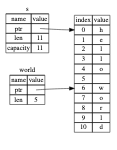String
Rust 字符串
String 和 &str
Rust 有两种主要的字符串类型:String 和 &str。有什么区别?
- &str 是一个简单的字符串。当你写
let my_variable = "Hello, world!", 你创建了 &str,它的速度非常快。 - String 字符串是更复杂的字符串。它有点慢,并且功能更多。字符串是一个指针,在堆上有数据。
&str 和 String 都是 UTF-8,譬如:
// Rust 的 string 被表达为:&'static str,所有的用""包裹起来的字符串,都被声明成了一个不可变,静态的字符串。
let x = "Hello";
let x:&'static str = "Hello";
fn main() {
let name = "서태지"; // This is a Korean name. No problem, because a &str is UTF-8.
let other_name = String::from("Adrian Fahrenheit Țepeș"); // Ț and ș are no problem in UTF-8.
}
您甚至可以借助 UTF-8 编写表情符号。
fn main() {
let name = "😂";
println!("My name is actually {}", name);
}
那么为什么我们在 str 前面需要一个 & 而不是 String 呢?因为,str 是动态类型,例如,名字 “서태지” 以及 “Adrian Fahrenheit Țepeș” 堆栈上的大小不同:
fn main() {
println!("A String is always {:?} bytes. It is Sized.", std::mem::size_of::<String>()); // std::mem::size_of::<Type>() gives you the size in bytes of a type
println!("And an i8 is always {:?} bytes. It is Sized.", std::mem::size_of::<i8>());
println!("And an f64 is always {:?} bytes. It is Sized.", std::mem::size_of::<f64>());
println!("But a &str? It can be anything. '서태지' is {:?} bytes. It is not Sized.", std::mem::size_of_val("서태지")); // std::mem::size_of_val() gives you the size in bytes of a variable
println!("And 'Adrian Fahrenheit Țepeș' is {:?} bytes. It is not Sized.", std::mem::size_of_val("Adrian Fahrenheit Țepeș"));
}
这就是为什么我们需要一个 & 的原因,因为 & 会创建一个指针,而 Rust 知道指针的大小。因此,指针进入堆栈。如果我们写了 str,Rust 将不知道要做什么,因为它不知道大小。有很多方法可以制作字符串。
类型互转
这里有一些:
String::from("This is the string text");这是用于 String 的方法,该方法采用文本并创建 String。"This is the string text".to_string(),这是 &str 的方法,使它成为 String。- format! 宏。这就像 println!除了它创建一个 String 而不是打印。因此,您可以执行以下操作:
fn main() {
let my_name = "Billybrobby";
let my_country = "USA";
let my_home = "Korea";
let together = format!(
"I am {} and I come from {} but I live in {}.",
my_name, my_country, my_home
);
}
现在我们有了一个在一起命名的字符串,但尚未打印出来。此外,我们还可以使用 .into() 来创建字符串,某些类型可以使用 from 和 .into() 轻松地与其他类型进行转换;如果您有 From,那么您也有.into()。from 更清晰,因为您已经知道类型:您知道 String::from("Some str") 是来自 &str 的 String。但是使用 .into(),有时编译器不知道:
fn main() {
let my_string = "Try to make this a String".into(); // ⚠️
}
// Rust doesn't know what type you want, because many types can be made from a &str.
error[E0282]: type annotations needed
--> src\main.rs:2:9
|
2 | let my_string = "Try to make this a String".into();
| ^^^^^^^^^ consider giving `my_string` a type
fn main() {
let my_string: String = "Try to make this a String".into();
}
我们也可以使用 &* 符号将 String 转化为 &str 类型:
fn use_str(s: &str) {
println!("I am: {}", s);
}
fn main() {
let s = "Hello".to_string();
use_str(&*s);
}
首先呢,&* 是两个符号 & 和 * 的组合,按照 Rust 的运算顺序,先对 String 进行 Deref,也就是 * 操作。由于 String 实现了 impl Deref<Target=str> for String,这相当于一个运算符重载,所以你就能通过 * 获得一个 str 类型。但是我们知道,单独的 str 是不能在 Rust 里直接存在的,因此,我们需要先给他进行 & 操作取得 &str 这个结果。
索引访问
有人会把 Rust 中的字符串和其惯用的字符串等同起来,于是就出现了如下代码
let x = "hello".to_string();
x[1]; //编译错误!
Rust 的字符串实际上是不支持通过下标访问的,但是呢,我们可以通过将其转变成数组的方式访问
let x = "哎哟我去".to_string();
for i in x.as_bytes() {
print!("{} ", i);
}
println!("");
for i in x.chars() {
print!("{}", i);
}
x.chars().nth(2);
格式化字符串
Rust 采取了一种类似 Python 里面 format 的用法,其核心组成是五个宏和两个 trait:format!、format_arg!、print!、println!、write!;Debug、Display。相信你们在写 Rust 版本的 Hello World 的时候用到了print!或者println!这两个宏,但是其实最核心的是format!,前两个宏只不过将format!的结果输出到了 console 而已。
fn main() {
let s = format!("{1}是个有着{0:>0width$}KG重,{height:?}cm高的大胖子",
81, "wayslog", width=4, height=178);
// 我被逼的牺牲了自己了……
print!("{}", s);
}
format_string := <text> [ format <text> ] *
format := '{' [ argument ] [ ':' format_spec ] '}'
argument := integer | identifier
format_spec := [[fill]align][sign]['#'][0][width]['.' precision][type]
fill := character
align := '<' | '^' | '>'
sign := '+' | '-'
width := count
precision := count | '*'
type := identifier | ''
count := parameter | integer
parameter := integer '$'
字符串切片
另一个没有所有权的数据类型是 slice。slice 允许你引用集合中一段连续的元素序列,而不用引用整个集合。字符串 slice(string slice)是 String 中一部分值的引用,它看起来像这样:
let s = String::from("hello world");
let hello = &s[0..5];
let world = &s[6..11];
这类似于引用整个 String 不过带有额外的 [0..5] 部分。它不是对整个 String 的引用,而是对部分 String 的引用。可以使用一个由中括号中的 [starting_index..ending_index] 指定的 range 创建一个 slice,其中 starting_index 是 slice 的第一个位置,ending_index 则是 slice 最后一个位置的后一个值。在其内部,slice 的数据结构存储了 slice 的开始位置和长度,长度对应于 ending_index 减去 starting_index 的值。所以对于 let world = &s[6..11]; 的情况,world 将是一个包含指向 s 第 7 个字节(从 1 开始)的指针和长度值 5 的 slice。

对于 Rust 的 .. range 语法,如果想要从第一个索引(0)开始,可以不写两个点号之前的值。换句话说,如下两个语句是相同的:
let s = String::from("hello");
let slice = &s[0..2];
let slice = &s[..2];
依此类推,如果 slice 包含 String 的最后一个字节,也可以舍弃尾部的数字。这意味着如下也是相同的:
let s = String::from("hello");
let len = s.len();
let slice = &s[3..len];
let slice = &s[3..];
也可以同时舍弃这两个值来获取整个字符串的 slice。所以如下亦是相同的:
let s = String::from("hello");
let len = s.len();
let slice = &s[0..len];
let slice = &s[..];
字符串 slice range 的索引必须位于有效的 UTF-8 字符边界内,如果尝试从一个多字节字符的中间位置创建字符串 slice,则程序将会因错误而退出。
